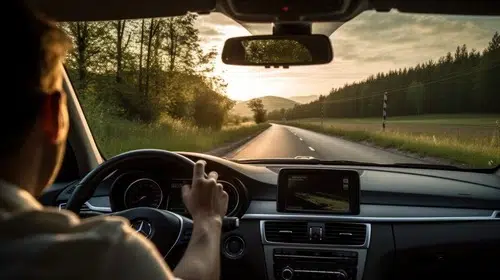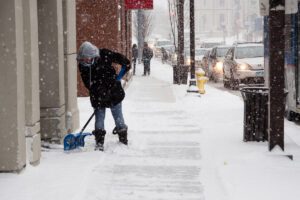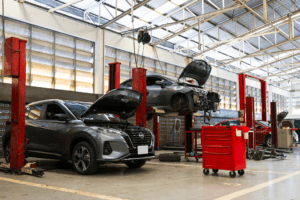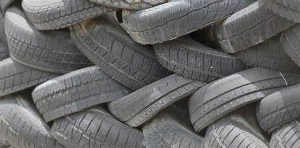What is the National Speed Limit in the UK?

Whether you’ve just passed your test or you’ve been driving for years, the national speed limit is essential knowledge. You’re always expected to know what the speed limit is, even if there aren’t any signs — and sticking to the correct speed limit is a legal requirement. But what is the national speed limit in the UK? How do you know how fast you can go?
Here’s your complete introduction to UK national speed limit laws. We’ll look at how speed limits change for different vehicles and road types, what the national speed limit sign looks like, as well as what happens if you’re caught speeding.
What is the national speed limit?
The UK national speed limit is different depending on the class of vehicle you’re driving and the road you’re on.
For most cars, the default speed limit is 70 mph on a motorway or dual carriageway, 60 mph on a single carriageway and 30 mph in a built-up area.
Here’s a breakdown of the most common vehicle types.
Built-up AreaSingle CarriagewayDual CarriagewayMotorwayCars, motorbikes and car-derived vans30 mph60 mph70 mph70 mphCars, motorbikes and car-derived vans (towing a caravan)30 mph50 mph60 mph60 mphMotorhomes under 3.05 tonnes (max unladen weight)30 mph60 mph70 mph70 mphMotorhomes over 3.05 tonnes (max unladen weight)30 mph50 mph60 mph70 mphBuses, coaches and minibuses (under 12 metres length)30 mph50 mph60 mph70 mphBuses, coaches and minibuses (over 12 metres length)30 mph50 mph60 mph70 mphGoods vehicles (under 7.5 tonnes max laden weight)30 mph50 mph60 mph70 mph60 mph if towing a trailer or articulatedGoods vehicles (over 7.5 tonnes max laden weight)30 mph50 mph60 mph60 mph
If you don’t see any signs by the side of a road, it’s sensible to assume the national speed limit applies.
Even if you haven’t realised, you’ve probably seen a national speed limit sign before. These circular road signs feature a white background with a diagonal black stripe going straight through it. You might find them on their own or on lampposts. They’re normally at the side of the road, but sometimes overhead on motorways.
Because the national speed limit changes depending on the type of road you’re on and the vehicle you’re driving, it doesn’t show a specific number.
The only exception is if you’re in a built-up area. In this case, the national speed limit of 30 mph is signed differently, because it’s the same limit for all sorts of vehicles. Here, you’ll just see the number 30 in a red circle.
Is the national speed limit 60 or 70?
OK, so here’s where it gets a bit confusing.
It’s both.
The national speed limit depends on where and what you’re driving.
But if you’re driving a car or motorbike on a motorway or dual carriageway, the national speed limit is 70 mph. If you’re driving a car towing a trailer, it’s a 60 mph speed limit. This is the highest speed limit for any UK road.
While many people think a dual carriageway just means a road with two lanes in each direction, this isn’t actually the case. A dual carriageway refers to any road with a central reservation separating traffic (this could be a grass verge or those metal barriers you see on motorways).
So technically speaking, you could have a single-lane dual carriageway, or even a triple-lane dual carriageway – as long as the traffic in each direction is separated.
No matter how many lanes there are, the national speed limit of 70 mph applies.
You’ll normally see a national speed limit sign at the start and end of the road. If it’s anything less than 70 mph (for instance if there’s a hidden driveway or a relatively sharp turn), this will be clearly signed.
When did the 70 mph limit come in?
The 70 mph national speed limit was introduced in 1965. Yes, it’s been around and remained unchanged for that long!
But why?
Well, when motoring was relatively new, speeding laws were pretty extreme. The “Red Flag Act” of 1865 had people walking ahead of any car, warning pedestrians on either side. At this time, speed limits were a sedate 2 mph in towns and 4 mph on rural roads.
But people soon grew tired of these slow speeds. So in 1931 speed limits were abolished altogether.
While a limit of 30 mph in built-up areas was brought back in 1935, once you hit the open roads, there were no restrictions at all.
This worked fine for a while, as cars weren’t that fast anyway. But cut to 1964 and a sports car manufacturer (AC Cars) tested their latest creation along the M1. Hurtling along the motorway at over 180 mph, they caused a public outrage.
Trouble was, this wasn’t actually illegal…
After this furore and several high-profile crashes, the national speed limit of 70 mph (outside built-up areas) was introduced in 1965. After a successful trial period of four months, it was renewed in 1966 and made permanent the following year.
Ten years later, the national speed limit was reduced to 60 mph on single-carriageway roads – and remains so to this day.
Can you do 80 mph on a motorway?
In short, no.
You can’t do 80 mph on a motorway without breaking the law.
And yes, this even applies when you’re overtaking. Contrary to popular belief, you run the risk of a fine as soon as you hit 71 mph.
The motorway speed limit in the UK is 70 mph.
Always remember though, speed limits might change. If there’s lots of traffic and digital signs overhead flash up with a 60 mph limit (for example), this isn’t just advisory.
Whether you’re on a regular motorway or a smart motorway, the variable speed limit overrules the normal national speed limit.
What is the national speed limit on a country road?
The national speed limit for country roads is 60 mph. It’s 50 mph for a car towing a trailer.
Technically known as “single carriageways”, these are just roads where the traffic going each way isn’t separated. Just think of a road you can cross as a pedestrian without navigating a barrier or verge.
A carriageway refers to the road as a whole, not the lanes of traffic. This means that a winding country lane is a single-carriageway. But it also means a road with two or three lanes of traffic is a single carriageway – as long as it doesn’t have a barrier in the middle!
Now, this doesn’t mean you have to go 60 mph of course. As always with speed limits, this is the absolute maximum speed allowed. You could be going under this and still driving too fast for the road conditions. Keep basic road safety in mind, and reduce your speed whenever necessary.
It’s important to remember that narrow country roads often don’t have pavements. So you might come across vulnerable road users like pedestrians, cyclists or horse riders. If 60 mph won’t let you slow down or stop in time, consider reducing your speed.
What is the speed limit for a built-up area?
The national speed limit for built-up areas is 30 mph.
You’ll normally see a sign with 30 in the middle to indicate this. But even if you don’t, as soon as you hit a village, town or city – 30 mph is a safe bet.
The national speed limit is lower in towns and cities for the simple reason there are more people about.
Pedestrians might step out into the road, or you might have to swerve to avoid an opening car door. With lots of traffic lights, junctions and roundabouts, there’s also more stop-start traffic. When things are unpredictable, it’s safer for everyone to go slower.
But how can you tell if you’re in a built-up area?
As a rule of thumb, look for street lighting. If you see lampposts, then chances are you’re in a built-up area.
Technically speaking, if there are three or more street lights in a row (no more than 183 metres or 200 yards apart), it’s a built-up area. These zones always have a national speed limit of 30 mph.
Do remember you might also find other traffic rules, like a 20 mph zone near schools or some residential areas. These additional rules are set by local authorities and will always be clearly signed.
What happens if you’re caught speeding?
If you’re caught speeding, you’ll receive a speeding ticket with a minimum £100 fine. You’ll also get a minimum of three penalty points on your licence.
You’ll get a Notice of Intended Prosecution (NIP) through the post, addressed to the registered keeper of the vehicle. You’ll have to complete and return this – giving the details of the person driving the car at the time. The driver will then get a Fixed Penalty Notice through the post.
In more extreme cases (say, going 70 mph in a built-up area) you could get up to six penalty points. You might even lose your licence altogether.
If this happens again, and you get more than 12 penalty points in three years, you could be banned from driving full stop.
For any new or learner drivers, if you get more than six penalty points within two years of passing your test, you’ll also have your licence taken away. This also means future car insurance will probably be more expensive.
Remember, speed limits in the UK are absolute. This means that even if you’re going just 31 mph in a 30 zone, you could still be charged.
Having said this, most speed cameras and police forces use discretion. This is usually around 10% of the speed limit. But don’t rely on this! Ultimately, the speed limit is the limit.
In summary
The national speed limit for most cars and motorcycles is 30 mph for a built-up area, 60 mph for a single carriageway and 70 mph for a dual carriageway or motorway.
The 70 mph limit was introduced in 1965. This means you can’t do 80 mph on a motorway, even if you’re overtaking.
The national speed limit changes depending on the vehicle you’re driving and the road you’re on. If you go over the maximum speed limit, you run the risk of fines, penalty points and possible collisions. In more extreme cases, you could end up banned from driving altogether – so make sure you stay in the know and always obey the rules of the road!



